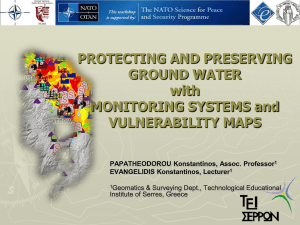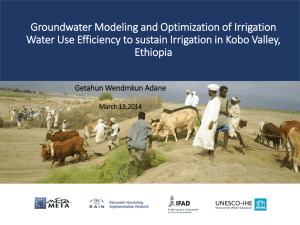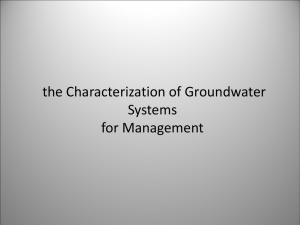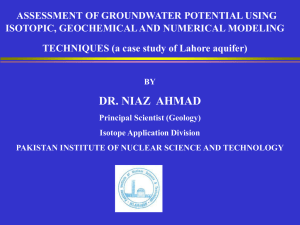Wallkill Watershed Groundwater in Living Color
advertisement
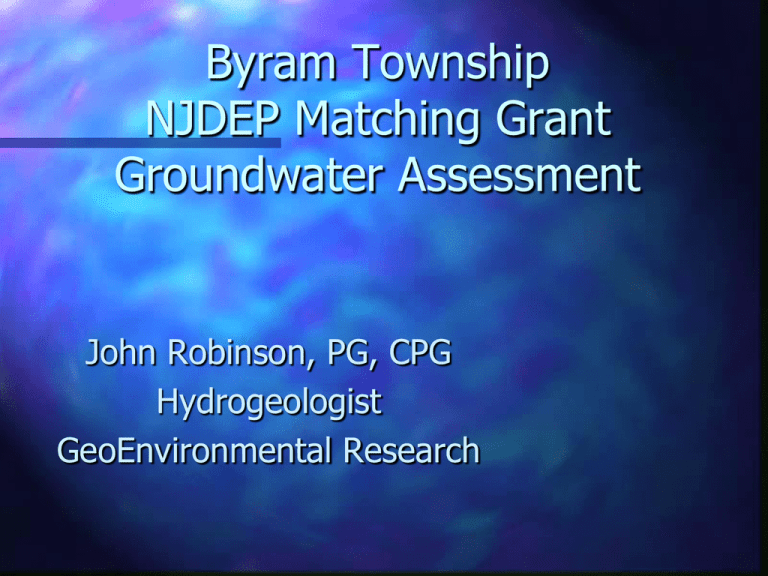
Byram Township NJDEP Matching Grant Groundwater Assessment John Robinson, PG, CPG Hydrogeologist GeoEnvironmental Research Project Tasks to Evaluate Byram’s Water Resources Prepare Aquifer GIS Maps Gather Information Collect Baseflow stream samples Prepare Aquifer Testing Ordinance Prepare Report Prepare Educational Slide Show Topics of Discussion Geology and Groundwater Occurrence Aquifer Materials Groundwater Contamination Residential Well Testing Groundwater Occurrence Hydrologic Cycle Runoff and Recharge Recharge and Discharge Changes in the Water Table Precipitation may runoff, evaporate, percolate to root zone, or enter aquifer. Water table changes seasonally. Aquifers vary with geology Precipitation that enters the aquifer flows directionally from recharge areas to discharge areas. The constant flow of groundwater that discharges into a stream is called baseflow. Baseflow water samples may be collected from streams to evaluate the quality of the discharging groundwater. Lubbers Run Upstream Sample Location. Groundwater supply wells may alter the natural flow groundwater. Pumping wells depress the water table around the intake. The localized decline is called a cone of depression. Water drawn from a stream into a well through the aquifer is called induced infiltration. Public Community Supply Wells This groundwater physical flow mode simulates the recharge/discharge and baseflow of a stream system. Water is added to the sides as recharge and migrates to the middle (steam) as discharge. Dye traces the groundwater flow paths. Shallow to deep flow paths migrate to the stream as baseflow discharge. Groundwater physical model depicting injection scenario common in septic systems. Notice mounding and radiating flow paths that spread out before reaching the water table. Groundwater flow concepts applied to typical Wallkill Watershed aquifer. Water table occurs as a subdued replica of the surface topography. Notice the water table is deeper at the upland watershed boundary and intersects the ground surface at wetlands and streams. Town well may draw from both groundwater and surface water. Physical model depicting flow to a well. Notice the cone of depression and flow paths to the well intake. Deeper flow paths may be influenced by pumping but escape intake. Groundwater discharge from a bedrock outcrop. Position of the water table surface is clearly visible. Aquifer Materials Unconsolidated Deposits Bedrock Limestone and Karst Sand and gravel deposit in the Waterloo section of Byram depicts the coarse grained and permeable nature of glacial outwash aquifers. The Aquifers of Byram Glacial Sediments and Surfacial Aquifers Surficial Aquifers Buried valleys in the Northern NJ area were formed by glaciers and the release of sediments in the ice interacting and deposited with the meltwater. Groundwater in bedrock aquifers flows through interconnected fractures. Fractures close at depth with increased lithostatic pressure. Wells that miss the interconnected fracture network may be dry. Bedrock Aquifers This fractured crystalline bedrock outcrop along Lakawanna Road is typical of the upland areas of the watershed. Notice the irregular occurrence of the fracture network. Limestone outcrop along Route 15 in Sparta. This type of bedrock is typical beneath the valleys in the Wallkill Watershed. Notice the more regular spaced and frequent bedding plane fractures. Limestone outcrop along Route 94 in McAfee. Notice the soluble nature of limestone. Groundwater Recharge Soil filled vertical fracture in limestone. Quantitative Hydrogeology Groundwater and Baseflow Gradient and Hydraulic Conductivity Testing Seasonal changes in the water table is accompanied with a change in gradient and volume of baseflow. Aquifer yield is evaluated by conducting an aquifer pump test. A controlled pumping stress is applied to the aquifer and the results are measured and interpreted. Pumping wells spaced too close together may create cumulative drawdown. Groundwater Contamination Sources of Contamination Well Head Protection Contamination threats to groundwater are everywhere. They may be organic, inorganic or both. Each type reacts differently in the subsurface. Organic chemicals, such as petroleum based fuel, have a specific gravity less than water and float on the water table. Their subsurface movement is influenced by the direction of groundwater flow, including the rising and falling of the water table. Chlorinated organic chemicals, such as dry cleaning fluid (TCE) and PCBs are denser than water and sink to an impermeable layer. The migration of dense non-aqueous phase liquids (DNAPLS) is dictated by gravity, not the direction of groundwater flow. In areas serviced by septic systems, delivery of chemicals into the subsurface is as common as going to the supermarket. Septic systems work by maintaining vertical unsaturated separation of at least 4 feet between the leach field and groundwater. In high volume systems, the vertical separation is rarely unsaturated. Septic Suitable Soils Karst aquifers have special problems. The enhanced permeability created by solution makes them exceptional aquifers. Unfortunately, this characteristic also makes them extremely vulnerable to contamination by run-off short-circuiting through sinkholes. Contaminant Threats in Byram Well head protection identifies the ground surface areas around wells which contribute to direct recharge of the well. The commonly used arbitrary fixed radius method of delineating well head protection areas is just that - arbitrary. No thought is given to pumping rates, aquifer properties or anything scientific. Its use may be justified by political motives, such as preserving current zoning. Calculated fixed radius is simplistic but considers properties such as pumping rates. Well Head Protection Areas Known Contaminant Threats Things to Remember Groundwater is out of sight, but not mysterious Groundwater can be protected with thoughtful planning Runoff is episodic and baseflow is constant The landscape and movement of water and contaminants is dictated by underlying geology. Next Steps Collect Additional Well Information Implement Residential Well Ordinance Identify Vulnerable Environments Plan to protect Vulnerable Environments From contaminants and groundwater mining.





